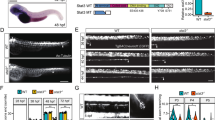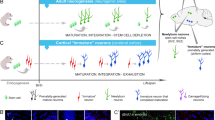Abstract
Signal transducers and activator of transcription (STAT) proteins are activated in response to many cytokines and growth factors. Many studies indicated that regulation of STAT expression plays an important role in survival, growth, and differentiation of neurons and glias in response to ciliary neurotropic factor, including rehabilitation of rat cortical injury, nerve regeneration, gangliosides-mediated stimulation of rat and murine primary microglia, and differentiation of retinal neurons. In this study, we use olfactory bulb neurons as a useful model, which undergo strong neurogenesis throughout adulthood. Our research demonstrated that low level of STAT3 expression facilitates the terminal differentiation of olfactory bulb neurons as well as induces the generation of neurons from neural stem cells, which can be potentially used in future therapies. On the contrary, activation of STAT3 expression is essential to the maintenance of stem-like status in olfactory cells. This activation can be manipulated by leukemia inhibitory factor (LIF), a member of cytosolic tyrosine kinases. All these results implicate that STAT3 serves as a critical protein in regulating the differentiation state in neural cells.





Similar content being viewed by others
References
Doetsch F, Caille I, Lim DA et al (1999) Subventricular zone astrocytes are neural stem cells in the adult mammalian brain. Cell 97:703–716. doi:10.1016/S0092-8674(00)80783-7
Gould E, Reeves AJ, Graziano MS et al (1999) Neurogenesis in the neocortex of adult primates. Science 286:548–552. doi:10.1126/science.286.5439.548
Eriksson PS, Perfilieva E, Bjork-Eriksson T et al (1998) Neurogenesis in the adult human hippocampus. Nat Med 4:1313–1317. doi:10.1038/3305
Gage FH, Ray J, Fisher LJ (1995) Isolation, characterization, and use of stem cells from the CNS. Annu Rev Neurosci 18:159–192
Darren JM, Andrew BW, Valina LD et al (2005) Molecular pathophysiology of Parkinson’s disease. Annu Rev Neurosci 28:57–87
Haeri M, Sarbaz Y, Gharibzadeh S (2005) Modeling the Parkinson tremor and its treatments. J Theor Biol 236:311–322
Petroske E, Meredith GE, Callen S et al (2001) Mouse model of Parkinsonism: a comparison between subacute MPTP and chronic MPTP/probenecid treatment. Neuroscience 106:589–601
Elizabeth AM, Noelle PL, Leonard IZ (2004) The clinical potential of stem cells. Curr Opin Cell Biol 16:713–720
Mackay-Sim A, Chuah MI (2000) Neurotrophic factors in the primary olfactory pathway. Prog Neurobiol 62:527–559
Andréanne B, Andre P (2004) Evidence of newly generated neurons in the human olfactory bulb. Dev Brain Res 151:159–168
McKay R (1997) Stem cells in the central nervous system. Science 276:66–71
Gage FH (2000) Mammalian neural stem cells. Science 287:1433–1438
Kim JH, Auerbach JM, Rodriguez-Gomez JA et al (2002) Dopamine neurons derived from embryonic stem cells function in an animal model of Parkinson’s disease. Nautre 418:50–56
Olanow CW, Kordower JH, Freeman TB (1996) Fetal nigral transplantation as a therapy for Parkinson’s disease. Trends Neurosci 19:102–109
Baier PC, Schindehutte J, Thinyane K et al (2004) Behavioral changes in unilaterally 6-hydroxy-dopamine lesioned rats after transplantation of differentiated mouse embryonic stem cells without morphological integration. Stem Cells 22:396–404
Ostenfeld T, Svendsen CN (2004) Requirement for neurogenesis to proceed through the division of neuronal progenitors following differentiation of epidermal growth factor and fibroblast growth factor-2-responsive human neural stem cells. Stem Cells 22:798–811
Murphy M, Dutton R, Koblar S et al (1997) Cytokines which signal through the LIF receptor and their actions in the nervous system. Prog Neurobiol 52:355–378
Huang EJ, Reichardt LF (2001) Neurotrophins: roles in neuronal development and function. Annu Rev Neurosci 24:677–736
Cafferty WB, Gardiner NJ, Gavazzi I et al (2001) Leukemia inhibitory factor determines the growth status of injured adult sensory neurons. J Neurosci 21:7161–7170
Cafferty WB, Das P, Gardiner NJ et al (2004) Conditioning injury-induced spinal axon regeneration fails in interleukin-6 knockout mice. J Neurosci 24:4432–4443
Cafferty WB, Gardiner NJ, Gavazzi I et al (2001) Leukemia inhibitory factor determines the growth status of injured adult sensory neurons. J Neurosci 21:7161–7170
Murphy M, Reid K, Brown MA (1993) Involvement of leukemia inhibitory factor and nerve growth factor in the development of dorsal root ganglion neurons. Development (Cambridge, UK) 117:1173–1182
Murphy M, Reid K, Ford M (1994) FGF2 regulates proliferation of neural crest cells, with subsequent neuronal differentiation regulated by LIF or related factors. Development (Cambridge, UK) 120:3519–3528
Mi H, Barres BA (1999) Purification and characterization of astrocyte precursor cells in the developing rat optic nerve. J Neurosci 19:1049–1061
Ihle JN (2001) The Stat family in cytokine signaling. Curr Opin Cell Biol 13:211–217
Bryan PH, Roger BV, Tricia AP et al (1999) Complex conserved organization of the mammalian leukemia inhibitory factor gene: regulated expression of intracellular and extracellular cytokines. J Immunol 162:4637–4646
Gadient RA, Patterson PH (1999) Leukemia inhibitory factor, interleukin 6, and other cytokines using the GP130 transducing receptor: roles in inflammation and injury. Stem Cells 17:127–137
Schweizer U, Gunnersen J, Karch C et al (2002) Conditional gene ablation of STAT3 reveals differential signaling requirements for survival of motoneurons during development and after nerve injury in the adult. J Cell Biol 156:287–297
Wu YY, Bradshaw RA (1996) Induction of neurite outgrowth by interleukin-6 is accompanied by activation of STAT3 signaling pathway in a variant PC12 cell (E2) line. J Biol Chem 271:13023–13032
Jin Q, William BJ, Stephen BM et al (2005) Conditioning injury-induced spinal axon regeneration requires signal transducer and activator of transcription 3 activation. J Neurosci 25:1645–1653
Rhee KD, Goureau O, Chen S et al (2004) Cytokine-induced activation of signal transducer and activator of transcription in photoreceptor precursors regulates rod differentiation in the developing mouse retina. J Neurosci 24:9779–9788
Park SJ, Nakagawa T, Kitamura H et al (2004) IL-6 regulates in vivo dendritic cell differentiation through STAT3 activation. J Immunol 173:3844–3854
DeFraja C, Conti L, Govoni S et al (2000) STAT signalling in the mature and aging brain. Int J Dev Neurosci 18:439–446
Gao Q, Wolfgang MJ, Neschen S et al (2004) Disruption of neural signal transducer and activator of transcription 3 causes obesity, diabetes, infertility, and thermal dysregulation. Proc Natl Acad Sci USA 101:4661–4666
Ronnett GV, Hester LD, Snyder SH (1991) Primary culture of neonatal rat olfactory neurons. J Neurosci 11:1243–1255
Farbman AI, Margolis FL (1980) Olfactory marker protein during ontogeny: immunohistochemical localization. Dev Biol 74:205–215
Buiakova OI, Krishna NS, Getchell TV (1994) Human and rodent OMP genes: conservation of structural and regulatory motifs and cellular localization. Genomics 20:452–462
Gearing DP, Gough NM, King JA et al (1987) Molecular cloning and expression of cDNA encoding a murine myeloid leukaemia inhibitory factor (LIF). EMBO J 6:3995–4002
Kwon YW, Abbondanzo SJ, Stewart CL et al (1995) Leukemia inhibitory factor influences the timing of programmed synapses withdrawal from neonatal muscles. J Neurobiol 28:35–50
Rao MS (1999) Multipotent and restricted precursors in the central nervous system. Anat Rec 257:137–148
Ostenfeld T, Svendsen CN (2004) Requirement for neurogenesis to proceed through the division of neuronal progenitors following differentiation of epidermal growth factor and fibroblast growth factor-2-responsive human neural stem cells. Stem Cells 22:798–811
Dragan M, Irina M, Yoong HC et al (2003) Prospective cell sorting of embryonic rat neural stem cells and neuronal and glial progenitors reveals selective effects of basic fibroblast growth factor and epidermal growth factor on self-renewal and differentiation. J Neurosci 23:240–251
Snyder EY, Taylor RM, Wolfe JH et al (1995) Neural progenitor cell engraftment corrects lysosomal storage throughout the MPS VII mouse brain. Nature 374:367–370
Johe KK, Hazel TG, Muller T et al (1996) Single factors direct the differentiation of stem cells from the fetal and adult central nervous system. Genes Dev 10:3129–3140
Snyder EY, Deitcher DL, Walsh C et al (1992) Multipotent neural cell lines can engraft and participate in development of mouse cerebellum. Cell 68:33–51
Acknowledgments
This work was sponsored by Mr. Baozhong Ren, Board Chairman of Jianrong Biochemistry and Nanomaterial Limited Corporation. We appreciate his technical and economic aids.
Author information
Authors and Affiliations
Corresponding author
Additional information
Yiqun Yu and Wenwen Ren contributed equally to this work.
Rights and permissions
About this article
Cite this article
Yu, Y., Ren, W. & Ren, B. Expression of signal transducers and activator of transcription 3 (STAT3) determines differentiation of olfactory bulb cells. Mol Cell Biochem 320, 101–108 (2009). https://doi.org/10.1007/s11010-008-9911-5
Received:
Accepted:
Published:
Issue Date:
DOI: https://doi.org/10.1007/s11010-008-9911-5




